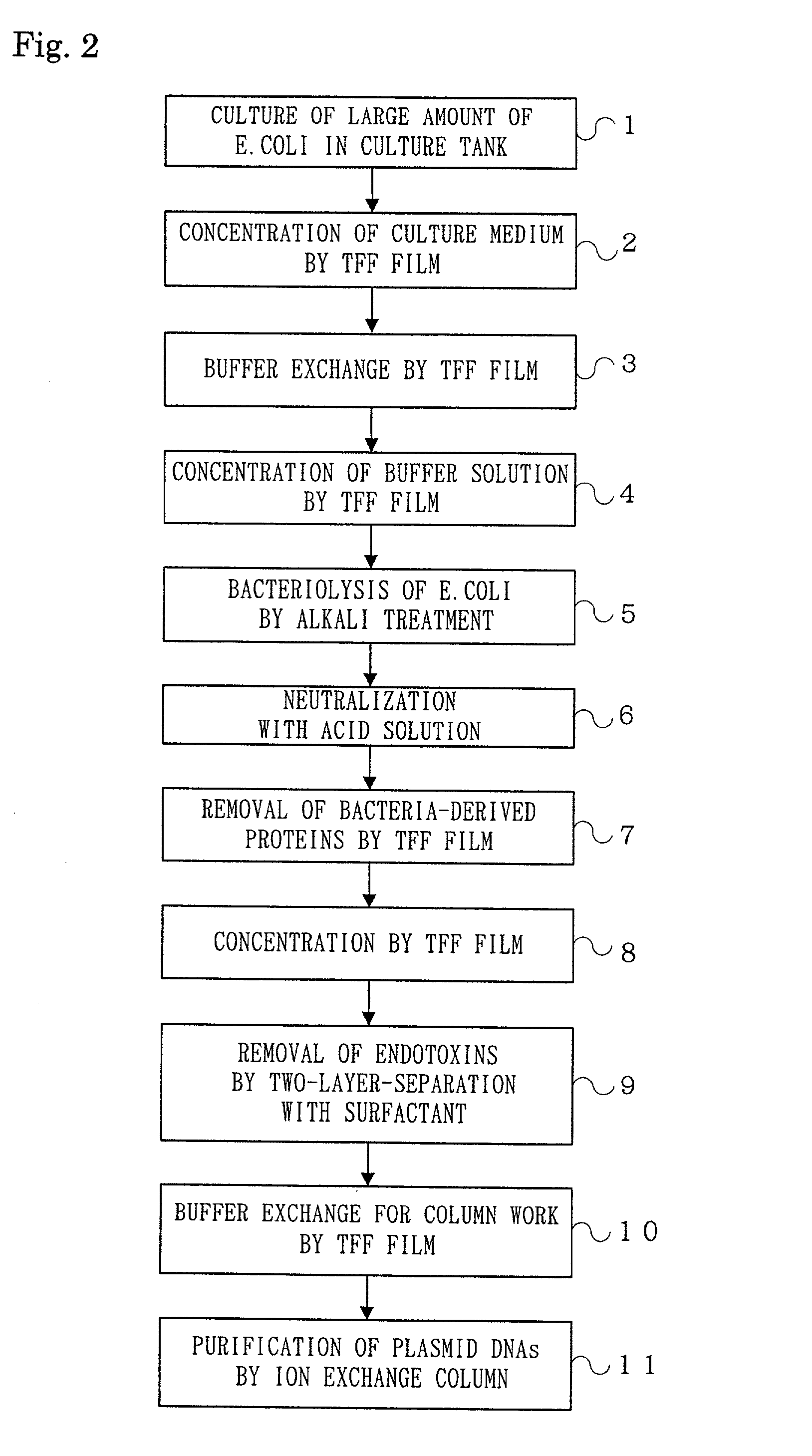Device and process for purifying vectors
a technology of purifying device and purifying process, which is applied in the field of devices and purifying process for vectors, can solve the problems of requiring some technical experience, affecting the purification effect, and a large amount of high-quality vectors,
- Summary
- Abstract
- Description
- Claims
- Application Information
AI Technical Summary
Benefits of technology
Problems solved by technology
Method used
Image
Examples
example 1
[0057] Firstly, Escherichia coli containing plasmids (beta gal plasmid vectors) was cultured in a culture tank containing 10 liters of LB culture media one night (14 hours). Then, the culture medium containing the Escherichia coli bodies was passed through a TFF film (Prostac, Dulapora PVDF 0.1 .mu.m, Millipore Co., Ltd.) to condense the solution to 1 liter.
[0058] Next, while 10 liters of a buffer solution (Tris-C125 mM, pH 8.0, EDTA 10 mM) (referred to as "TE" hereinafter) was supplied to the condensed culture medium, a mixture of theses solutions was passed through the TFF film (Prostac), thereby replacing the culture medium with the buffer solution. Further, the buffer solution was condensed to 1 liter by using the above TFF film (Prostac).
[0059] Next, 1 liters of a 200-mM NaOH solution (containing 1% of SDS) was added to the Escherichia coli body for bacteriolysis. Thereafter, 1 liter of 3.0-M potassium acetate (pH 5.5) was added to the above solution to neutralize the solution....
example 2
[0065] Pore sizes of the first TFF film 12 in FIG. 1 were studied.
[0066] Three pore sizes, i.e., 0.4 .mu.m, 0.22 .mu.m and 0.1 .mu.m, of the TFF film were studied using a culture medium containing Escherichia coli bodies. No significant differences in film pressure, filtration efficiency and the like were observed among the three pore sizes in the concentrating and buffer solution-replacing procedures, and the culture medium could be condensed with all the three pore sizes.
[0067] In the process of removing debris after bacteriolysis, no significant differences in film pressure, filtration efficiency and the like were observed among the three pore sizes of the TFF film. For the pore size of 0.1 .mu.m, the amount of residual proteins was less, compared with the other two sizes.
example 3
[0068] Pore sizes of the second TFF film 28 in FIG. 1 were studied.
[0069] Five pores sizes, i.e., 1,000 KDal, 300 KDal, 100 KDal, 50 KDal and 10 KDal, were studied. A crudely purified solution produced by the first TFF film having a pore size of 0.1 .mu.m was condensed by filtration films having the above five pore sizes.
[0070] As a result, when it was condensed by the 1,000-KDal and 300-KDal films, plasmid DNAs were observed in filtrates, while when it was condensed by the films having a pore size of 100 KDal or smaller, no plasmid DNAs were observed. Therefore, it was confirmed that the films having a pore size of 100 KDal or smaller had better concentration efficiency.
PUM
| Property | Measurement | Unit |
|---|---|---|
| Pore size | aaaaa | aaaaa |
| Pore size | aaaaa | aaaaa |
| Temperature | aaaaa | aaaaa |
Abstract
Description
Claims
Application Information
 Login to View More
Login to View More - R&D
- Intellectual Property
- Life Sciences
- Materials
- Tech Scout
- Unparalleled Data Quality
- Higher Quality Content
- 60% Fewer Hallucinations
Browse by: Latest US Patents, China's latest patents, Technical Efficacy Thesaurus, Application Domain, Technology Topic, Popular Technical Reports.
© 2025 PatSnap. All rights reserved.Legal|Privacy policy|Modern Slavery Act Transparency Statement|Sitemap|About US| Contact US: help@patsnap.com



